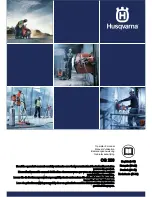
13
tor’s fan will draw the dust inside the housing
and excessive accumulation of powdered metal
may cause electrical hazards.
o)
Do not operate the power tool near flammable
materials.
Sparks could ignite these materials.
p)
Do not use accessories that require liquid
coolants.
Using water or other liquid coolants may
result in electrocution or shock.
4.2 Kickback and related warnings
Kickback is a sudden reaction to a pinched or
snagged grinding roller, expansion adapter, brush or any
other accessory. Pinching or snagging causes rapid
stalling of the rotating accessory which in turn
causes the uncontrolled power tool to be forced in
the direction opposite of the accessory’s rotation at
the point of the binding. For example, if an grinding wheel
is snagged or pinched by the workpiece, the edge of the
wheel that is entering into the pinch point can dig into
the surface of the material causing the wheel to climb
out or kick out. The grinding wheel may either jump
toward or away from the operator, depending on
direction of the disc’s movement at the point of
pinching. Abrasive tools may also break under
these conditions. Kickback is the result of power tool mi-
suse and/or incorrect operating procedures or conditions
and can be avoided if suitable precautionary measures
are taken as described below.
a)
Maintain a firm grip on the power tool and positi-
on your body and arm to allow you to resist kickback
forces. Always use handle for maximum control over
kickback or torque reaction during start-up.
The opera-
tor can control torque reactions or
kickback forces, if proper precautions are taken.
b)
Never place your hand near the rotating accessory.
Accessory may kickback over your hand.
c)
Do not position your body in the area where the
power tool will move if kickback occurs.
Kickback
will propel the tool in direction opposite to the grinding
wheel’s movement at the point of snagging..
d)
Use special care when working corners,
sharp edges etc. Avoid bouncing and snagging
the accessory.
Corners, sharp edges or bouncing
have a tendency to snag the rotating accessory and
cause loss of control or kickback.
4.3 Safety Warnings Specific for Sanding Operations:
a)
Do not use excessively oversized abrasive sleeves.
Follow manufacturers recommendations when selec-
ting abrasive sleeves.
Larger abrasive sleeves extending
beyond the expansion roller presents a laceration hazard
and may cause snagging, tearing of the sleeve
or kickback.
4.4 Safety Warnings Specific for Polishing Operations:
Do not allow any loose portion of the polishing bonnet
or its attachment strings to spin freely. Tuck away or
shorten the loose attachment strings.
Loose and
spinning attachment strings can entangle your fingers or
snag on the workpiece.
4.5 Safety Warnings Specific for Wire Brushing
Operations:
a)
Be aware that wire bristles are thrown by the
brush even during ordinary operation. Do not
overstress the wires by applying excessive
load to the brush.
The wire bristles can easily
penetrate light clothing and/or skin.
4.6 Additional Safety Instructions:
Use elastic cushioning layers if they have been
supplied with the grinding media and if required.
Observe the specifications of the tool or accessory
manufacturer!
Accessories must be stored and handled with care
in accordance with the manufacturer‘s instructions.
Ensure that accessories are installed in accordance
with the manufacturer‘s instructions.
The tool continues running after the machine has
been switched off.
Do not use separate reducing bushings or adapters
to adapt tools that were designed for different power
tools.
The workpiece must lay flat and be secured against
slipping, e.g. using clamps. Large workpieces must
be sufficiently supported.
A damaged or cracked handle must be
replaced. Never operate a machine with a defective
handle.
Only use the machine if the protective cover is in
place.
Always guide the machine with both hands on the
handles provided
4.7 Special safety instructions for mains powered
machines:
Pull the plug out of the socket before making any
adjustments, changing tools, carrying out maintenance
or cleaning. Before connecting the mains plug, make sure
that the machine is switched off. Use of a fixed extractor
system is recommended. Always install an RCD with a
maximum trip current of 30 mA upstream. If the angle
grinder is shut down via the RCD, it must be checked and
cleaned. See Chapter 9. Maintenance.
4.8 Reducing dust exposure:
Some of the dust created using this power tool
may contain chemicals known to cause cancer,
allergic reaction, respiratory disease, birth defects
or other reproductive harm. Some of these substances in-
clude: lead (in paint containing lead), mineral dust (from
bricks, concrete etc.), additives used for wood treatment
EN






































